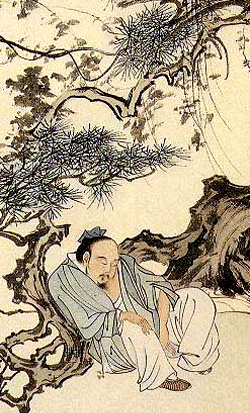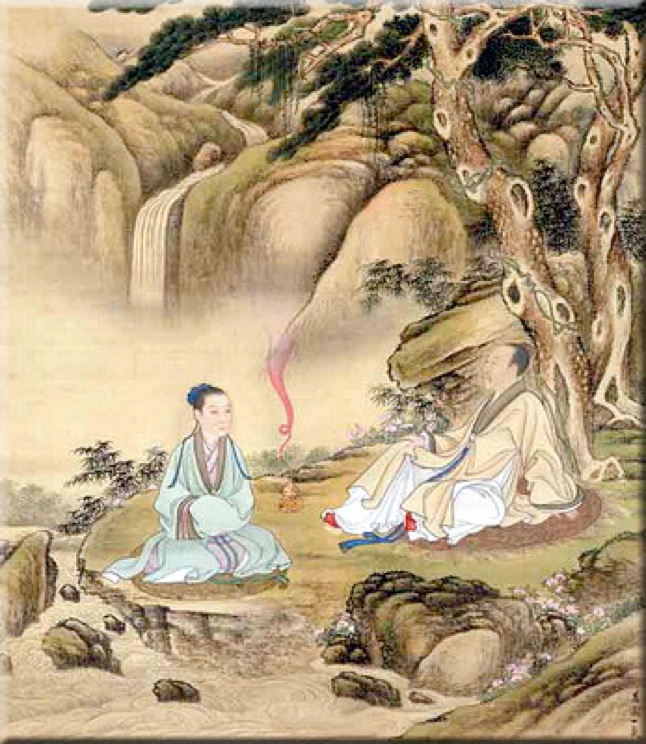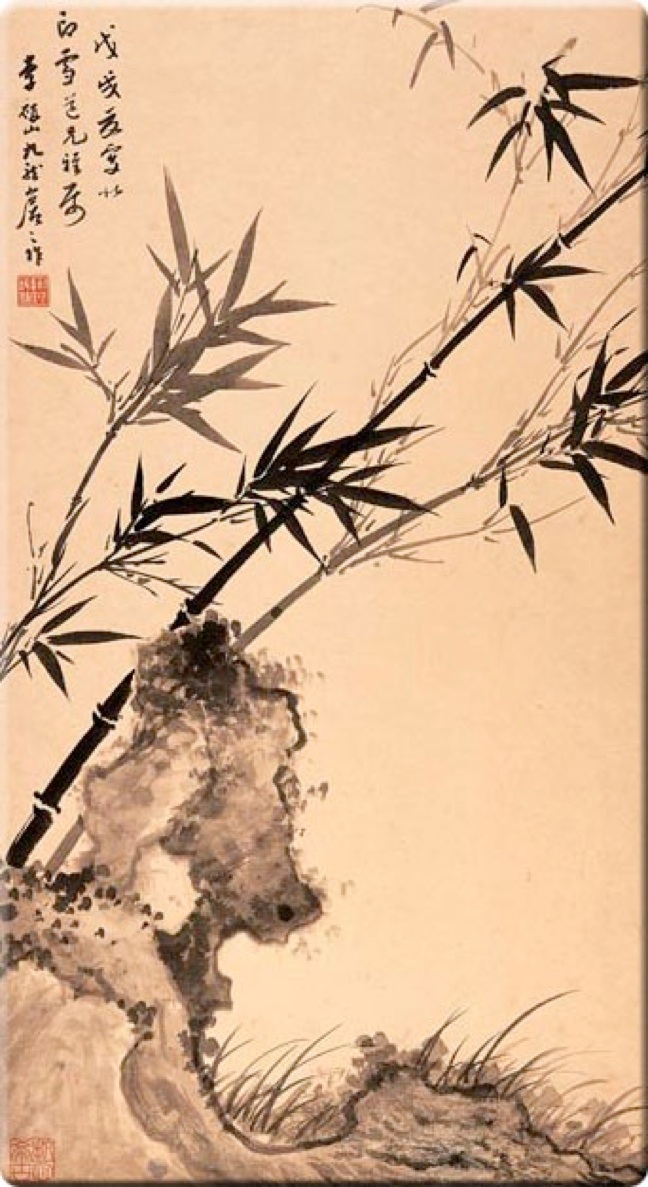A notion for Тао
philosophy and religion


A notion for Тао
philosophy and religion


THE BEGINNINGS OF TAOIST PHILOSOPHY
The Taoists trace their original founder to the Yellow Emperor, and even to the Divine Farmer. They consider all the hermit philosophers under the Five Ti Rulers as of their school. Lu Shang, the prime minister of the first Chou emperor and the founder of the Ch’i state, who is commonly known as Chiang T’ai Kung, was also a Taoist sage. The extant teachings of these ancient sages is very ambiguous.
The real beginnings of Taoism begins with Laotzu, the Old Master. According to Su-ma-Ch’ien, the historian, who lived at the beginning of the First Century B. c., Laotzu was the official historian and custodian of the secret archives of the Cheu state. He was an older contemporary of Confucius and records a visit which Confucius paid him. He also tells of Laotzu's passing the guard at the frontier and writing the book.
History tells us that there were two more early Taoists in the Chou Dynasty. Lao Lai Tsu, a native of the Ch’u state, wrote a book of fifteen chapters which has been lost. Another Taoist named Lao Tan, who was also a historian of the imperial house, lived in the same state. These three Taoist sages who lived 200 or more years apart, according to history, are commonly believed to be the same man, who by his wisdom had attained longevity. Because of this some modernist scholars question the very existence of Lao-tzu and ascribe everything to the Loa Tan, but the simpler and more probable solution of the confusion is to accept the historicity of all three, but to give the credit for the original writing to Laotzu and consider the others as able disciples and possibly editors. The book in its present form might not have been written until the Third Century at about the time of Lao Tan for it was engraved on stone tablets soon after that time. It might even contain some of the verses by Lao Tan without detracting from the larger credit that belongs to Laotzu. There are a number of legends that have gathered about the name of Laotzu but which only serve to throw doubt upon his existence.
The Chinese character for Tao is difficult to translate. It is made up of two characters: shau, meaning to lead, or the head; and hsing, meaning to walk, or a trail. Tao, therefore, would carry the meaning of 'that which leads us to walk on trails.' From this comes the meaning, The Way, or The Path, and a second meaning, Law or Method. There is a third meaning, also, the Word, or to talk. Tao is one of the oldest and commonest words used in ancient Chinese literature. It was used long before the beginning of Taoist philosophy. The same word is also used in Confucian works and just as frequently. But it was the Taoists who generalized it and mystified it and brought it to mean, instead of a practical method for the conduct of life, the abstract and natural course of things, and the pure nature of the universe and of life.
Laotzu's conception of Tao is something formless, nameless, invisible, unspeakable. It exists from before the creation and will exist till after the dissolution of all things. It has neither beginning nor end; it never changes but witnesses and withstands all changes. Tao is the mother of all substances and is the motive of all movements. It is the only and the absolute law of the universe. Laotzu's conception of teh is, that it is the virtue of Tao, the original nature of Tao, and should, therefore, be practiced by all human beings. By following this primeval law and by living in a state harmonious with it, one would be following the true Way of life, which is teh. His view of the universe is expressed by the term, Tsu-jan, which means, 'by itself, so', that is, it is pure naturalism. Everything is what it is because of its own nature as it follows its natural course. Because of an endless chain of causes and effects and conditions it can not be otherwise. He did not believe in a personal God, nor even in supreme intelligence, nor in any final purpose. The universe is simply an ever flowing current. It moves by a certain force, in a certain direction, according to a certain formula, but with no fixed aim. His view of life is expressed by the term, wu-wei, which means, doing nothing, or inaction. The best thing one can do in life is to do nothing, or as near nothing as possible. One should reflect stimulating and responsive calls but must not go beyond this limit, nor take any part of the action from which he could be spared.
Laotzu was not an atheist but his conception of God and heaven is nothing more than nature. He is not an anarchist but his conception of government is to think according to people's thought and to treat them as little children. He was strongly opposed towar and to the resort to force in any form be it expressed by law or religious rites or social custom. He is the chief representative of the negative and passive phase of Chinese philosophy.
Next to Laotzu comes Chuangtsu who lived about a hundred years later. His given name was Chou, his surname was Nan Wha. He was a native of the Meng district now a part of Anhui. He was at one time an actuary of the Ch’i Yuan. Requested by the king of Ch’u to become a minister of state, he declined and retired to write a book of fifty-three chapters of which since the Han Dynasty only thirty-three survive. The book was canonized by the T’ang emperors and named, Nan-wha Chen Ching. It is the second most important of the Taoist classics. It is divided into three parts of which the first part, consisting of seven chapters, is the most important. One will find in it more profound ideas and more elaborate discussions than in Laotzu.
There are three other classics of importance. The Lieh Tsu, by Lieh Yu-kou of the Cheng state; Wen Tsu, by Chi-jan of the Yueh state; and Ken-sang Tsu, by a scholar of the Lu state. These are the five classics of Taoism. As to their authenticity there is some question. Wen-Tsu is the oldest and it contains more quotations from Laotzu than the others. These books, and others written before the Eastern Han Dynasty and before the beginnings of Taoism as a religion, are suitable as sources for the study of the philosophy of Taoism.
Taoists, and especially Laotzu and Chuangtsu, are exponents of ancient philosophy and are very passive and non-resistant. They have always been the most radical leaders of thought against the state religion based upon the teachings of Confucius, against any military supported government and against any social order built up on conventions. They have always advocated free thinking and free teaching and, in the early days, after the passing of the feudal age, opened a new era of Chinese civilization. All schools of philosophy of their day and thereafter, and this includes the Confucian, came under their influence. No philosopher however different his philosophy ever disputed the Taoist philosophy or its teachers. On the contrary, they all proclaimed in some measure to be derived from ancient Taoist teachings. Aside from the Taoist religion, the ancient Taoist teachings have had a very strong and permanent hold on Chinese life and thought both personal and collective. Taoist elements of thought lie at the basis of Chinese characteristics of patience, reserve, egotism, peacefulness, and contentment. Whether these characteristics are virtues or not, it is in these qualities that the Chinese characteristics and the Taoist teachings are identical. Though both Taoism and Confucianism have taught the same principles of Tao and teh with similar definitions in many respects, the Confucianists compared with the Taoists have taught a more positive and active presentation of them. The Confucianists emphasize human activities in forming civilization, while the Taoists advise merely a return to nature and an obedience to her laws. It is therefore the Confucian scholars of later days who have criticized Taoism as being a one-sided philosophy that is good only for retirement and is bad for government. Some Taoists have replied to this by saying that nature itself is evolutional is never at a standstill, and that their course is wiser because it falls in with nature instead of foolishly trying to change or expedite the natural process of things.
Laotzu's idea of a return to nature is, however, somewhat different from that. Laotzu advocates passivity because it is the safest position in which to undergo natural evolution; he advocates simplicity because it is the best attitude of mind to understand compliance. He depicts the cultivation of Tao and teh first in one's person, then in his family, then in his town, then in his state, and then in the whole world, which is the same order that Confucius taught in his Great Learning. Laotzu often discusses about government and state affairs. He uses the term 'the perfect Sage' frequently and by it generally refers to the ruler. By reviewing the glorious achievements of the early Han emperors who reigned according to Laotzu's understanding of the principle of Tao, we are convinced that the Taoist philosophy, though a negative philosophy, is not alone a philosophy for hermits.
TAOIST RELIGION
Religion is very different from philosophy, often it becomes quite opposite and yet it is carried on in its name and claims to be the original teaching. Sometimes this is caused by the inclusion of some alien elements, but in case of Taoism in China, from beginning to end it has been an indigenous faith. It took about 650 years from the time of Laotzu to its proclamation as a religion, to complete this transformation. The difference between Taoist philosophy and Taoist religion is so great that one can hardly find any connection; in fact, it is doubtful if there is any. All relations asserted by modern Taoists are uncertain and unreliable. The transformation, however, can be traced.
After the passing of the early Taoist teachers, its teachings were invaded and finally dominated by believers in the 'two forces' and the 'five elements' (male and female; earth, water, fire, air, ether) . From these two schools emerged. The first, the Ch’an Wei School, became mixed up with a Confucian school and gave birth to witchcraft. The second, the Shen Hsien School, was dominated by adepts in discerning the 'wind and water influence (fang-shih)' who practiced alchemy and the art of prolonging life. The first emperor of the Ch’in Dynasty fell a victim to these adepts and sent out emissaries to seek for this elixir of life. In the Western Han Dynasty the chief counsel of its founder, Chang Liang, was fond of this doctrine, andthe Emperor Wu-ti particularly favored it and made several unsuccessful attempts to find the philosopher's stone.
Under Emperor Kuang-wu of the Eastern Han Dynasty, in 34 A.D., Chang Tao-lin was born. It was by him that the Taoist religion was founded. He was a native of Chekiang Province although he spent most of his life in the Dragon-tiger mountain in Kang-si, where he lived and taught to an extremely old age; he spent a great deal of his time in meditation and lived to be 123 years of age.
A century elapsed. Then came the revolution of the Yellow Turbans who were followers of Chang Tao-lin and whose leader was a descendant of him. The revolution was soon suppressed but the religion continued and spread among the lower classes. Chang Tao-lin who had been called, "the Divine Teacher," was later honored by having this title (Tien-shih) made hereditary. This Taoist papacy still continues with its seat in the Dragon-tiger mountains. In the Western Chin Dynasty two independent adepts appeared (Ke-hung and Tao Hung-thing) who were famous for their wisdom and magical achievements. Later another Heavenly Teacher appeared during the Northern Wei Dynasty, in North China who was highly regarded by the Tartar Emperors. This man was K’ou Ch’ien-chieh of Chili, and through his influence Taoism became established for a time as a state religion. It was during this time (440 A.D.) that Buddhism was persecuted and Confucianism was neglected.
Since the founding of the T’ang Dynasty, owing to the fact that its founder claimed to be a descendant of Laotzu, Taoist philosophy and the Taoist religion have been highly honored and promoted. The Old Master, Laotzu, was honored and his four great disciples; many Taoist priests were summoned to court and placed in high government positions. In the beginning of the Northern Sun Dynasty, Ch’ien T’uan and Ting Shao-wei, two great Taoist scholars, were honored by both Emperors T’ai Tzu and T’ai Tsung. Ch’ien T’uan's philosophy had a strong influence over Confucianism, and was directly the foundation of the so-called orthodox school of Taoism. Emperor Huei Tsung of the same Dynasty was a renowned patron of Taoism. He was often called the Taoist King. He regulated the Taoist priesthood into twenty-six ranks and two high priests were made ministers of state. He even went so far as to order all Buddhists to become Taoists. This was in 1119. It was during this revival of Taoism that meditation (ch’u zan ch’un) was revived. The first Mongol Emperor Kublai confirmed the Taoist papacy, and made Chang Tsung-yen, the thirty-sixth generation from Chang Tao-lin, a member of the hereditary nobility (1275) .
In the Ming Dynasty a famous Taoist named Chang San-feng was summoned by the Emperor many times but never responded. Emperor Chia Ching in his long reign (1522-1566) devoted much attention to Taoist affairs and ordered Taoist sacrificial feasts throughout the Empire. Since the Ming Dynasty there has been a bureau in the central government to administer Taoist affairs, together with a similar Buddhist bureau. The Ch’ing Dynasty followed this system and made the heir of Chang Tao-lin, its honorary chief, an official of the fourth rank. The Changfamily have thus enjoyed hereditary rank second only to the family of Confucius.
In modern times there have been two great branches of Taoist teachings, the Cheng Yi and the Ch’uan Chen. The former is the orthodox sect and follows strictly Chang Tao-lin's religious practices. Each of the two branches is again divided into two schools. The two schools of the orthodox branch are called Fu-lu and K’e Chiao, and are both under the Papacy that had been founded in 1161 in the Ch’in Dynasty. The First Patriarch of the first orthodox school was Lu Tung-pin, a retired Chin-shih scholar of the T’ang Dynasty. They practice witchcraft and most acts of exorcism and necromancy are under this sect; they use cryptic monograms, charms, spells, amulets in their services, and produce various psychic phenomena. The ouija board was their invention and its name originated in Fukien. It is called Fu-chi in Mandarin. The second Orthodox school, the Ke Ch’iao, confine their attention to the study of forms and rites and the practice of medicine. They are also interested in Taoist literature and ceremonies which have been developed mainly after Buddhist patterns and their costumes and ceremonies are often decorative and graceful.
The first of the heterodox schools is called the Lien Yang, or Chen Yang, and is devoted to the practice of physical and mental hygiene. They believe in strengthening the body and mind as a means of prolonging life and developing the spirit. This is achieved by secret meditations and exchange of vibrations. The Fang Chung Shu method for developing inner character, and the science of 'sexual' transformations (a secret and cryptic word for the positive and negative principles) are important elements of their practices. The second of the heterodox schools is called the Fu-shih and their interests are related to the science of medicine and alchemy. They think that the life elements of the human body can be supplied either by herbal nourishment or by mental and spiritual sublimations. They value lead and mercury as means for transmuting into gold and in making an elixir of immortality. Most of these schools have northern and southern divisions. In general the Northern are more materialistic, the Southern more idealistic and less formal. *
As stated above, the Taoist religion is an abuse of Taoist philosophy. We find nothing essentially in common between them and, in many respects, they are conflicting. This is especially so between Laotzu's teachings and the orthodox Papacy. The true nature of the Taoist religion is a combination of the ancient animism, spiritism, mythology, and the popular superstitions of the day. Its formulation was chiefly influenced by imperial encouragement of the adepts and the social adoption of Buddhism. From the ancient animism and Buddhism, Chang Tao-lin made up the Taoist religion just as Mohammed made up Islam from early Judaism and Christianity. They both borrowed foreign faiths and conformed them to native ideas to suit their own purpose. Against Laotzu's atheistic tendency the Taoist religion created numerous divinities. Against his disapproval of names and forms, it manufactured voluminous scriptures, rituals and elaborate ceremonials. Against his belief in the simple quiet life it imitated the ranks and standards of nobles and officials. Misunderstanding and ignoring Laotzu's warning against greed and lust, many Taoist practices of alchemy and sexual 'gravitation' appeared disguised in secret teachings and cryptic terms. On the other hand, the Taoist religion borrowed from the Buddhists the conception of the 'three bodies' of Buddha, but interpreted it as meaning their ancient belief in the 'three purities':--Virility (Ching), Air (Ch’i), and Spirit (Shen). It enumerated the eight immortals and the twenty-eight star gods, and pictured the heavens and hells after the Buddhist tales, and they have adopted the Buddhist practice of saying masses for the dead.
Differing somewhat from the Buddhists many orthodox Taoist priests forsake their temples and brotherhoods to marry and live the ordinary life of the world. Taoists often use their surnames and wear long hair. There are none or very few Taoist nuns. During the change of Dynasties, particularly between the Ming and Ch’ing, many officials, soldiers and scholars refused to submit to Manchu customs and became Taoists, because they were the only ones who were allowed to keep old Chinese ways and wear long hair. Strangely enough, during the recent revolution, the Taoists were the last to lay aside their queues.
The influence of the Taoist religion in China is neither as strong as the influence of Buddhism or, the Taoist philosophy, but all the popular superstitions, practices and resort to geomantic magic, including spiritism and shamanism, can be regarded as Taoist in some form. The many revolutions of the Ch’ing Dynasty, besides the T’ai P’ing Christian and Mohammedan, were all connected more or less closely with the Taoist sects. Taoism has never created any great literature or art, as Buddhism and Confucianism has; it has never been the religion of the intellectual classes and has always been looked down upon by the literati.
/ from the HISTORICAL ESSAYS by DR. KIANG KANG-HU /
clock here below for text of Laotzu’s Tao Teh Qing






